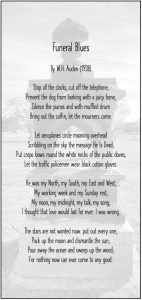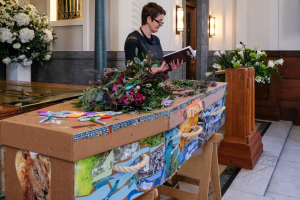9.5 Elegies & Eulogies
What is an Elegy?

Elegies are expressions of loss and mourning (Elegy, April 14, 2022). The word elegy is derived from the Greek word élegos, or funeral lament (Hirschi, 2014). “The poetry of lamentation, which arose in oral literature…, seems to exist in all languages and poetries” (e.g., ancient Egyptian, ancient Greek, Hebrew, Chinese, Sanskrit, Zulu) (Lament, n.d. para. 1). Elegies or lamentations can take various forms, ranging from meditative poems (sometimes accompanied by a flute, violin or piano) (Hirschi, 2014) to mournful songs (with or without lyrics). Although traditional elegies are outpourings of grief tied to death, in more recent times the use of elegies has expanded to include lamentations for someone or something that is gone or inaccessible, including lost loves tied to the ending of relationships, or as a personal reflection on loss and/or death (Buja, August 20, 2015).
Elegies
 Funeral Blues (see poem, above right) is a famous elegy by W.H. Auden (1938). As with many funeral elegies, it is often read along with a quiet, somber musical accompaniment.
Funeral Blues (see poem, above right) is a famous elegy by W.H. Auden (1938). As with many funeral elegies, it is often read along with a quiet, somber musical accompaniment.
Below are three videos that provide illustrations of the various forms that elegies can take.
VIDEO: In Memoriam A.H.H. (Canto 27) By Lord Tenneyson — Poetry Reading #19
In the following video Peter Brown performs an excerpt from the elegy In Memoriam, penned by a devastated Lord Tennyson following the sudden death of his dear friend, Arthur Henry Hallam (In Memoriam AHH, n.d.).
VIDEO: Neil Gow’s ‘Lament for the Death of His Second Wife’
In the following video, recorded at the Highwayman pub in Kidlington, Oxforshire UK, Jed Mugford, Kate McCullough and Mike Gardiner perform Neil Gow’s haunting lament.
MUSICAL PERFORMANCE: Condor’s Lament
In the following musical recording, Painted Raven performs “Condor’s Lament” from their 2004 CD Spirit Journey.
What is a Eulogy?
A eulogy is a written speech to memorialize, honour, and pay tribute to the deceased (Campbell, March 4, 2019). The term eulogy comes from the Greek word “eulogia”, meaning “praise” or “good” or “true words” (Johnson, August 11, 2022; Szczesniak, n.d.). The giving of a eulogy “is the last formal, public testament to a dead person’s life” (Mends, June 10, 2019). It is an opportunity to reflect on the person, what made them special or unique, the impact they had on other’s lives, their accomplishments, their lifetime social contributions — in other words, how they will be remembered (Campbell, March 4, 2019). The goal being to capture “the essence of the person” (Prepare, n.d.).


The tone of eulogies vary from somber, to light, with even some comical elements, depending on the person who is giving the eulogy, who is being eulogized, and how they died (Campbell, March 4, 2019) (see for example the eulogy given by John Cleese found via the link at the bottom of this page). The goal of a eulogy is to capture “the essence of the person”, through sharing stories that illustrate who they were. Including humour in parts of the story(ies) shared can make people laugh or wistfully smile, easing anxiety and temporarily lighten the mood (Isaacs, September 18, 2012). However, humour may not be appropriate in eulogies for people who died young or tragically.
Once written, eulogies are typically delivered to audiences in attendance at funerals, graveside during burials or interments, wakes, and during celebrations of life (Meade, n.d). Eulogies are usually between 5 and 15 minutes in length. During COVID-19, we saw many of these tributes either being broadcast or given online, increasing access and audience size.
Historically, eulogies were reserved for public figures. However, as familial/community proximity to death increased with the emergence and professionalization of the funeral industry in North America during the late 1800s (Lundgren & Houseman, 2010) (see Chapter on Historical Beliefs & Death-Related Practices), eulogies have become popularized as a way to honour our loved ones (Campbell, March 4, 2019).
Eulogy Videos
The first two eulogies are somber, heart-felt remembrances, delivered by family members of two Canadian police officers killed in the line of duty in 2022.
Click the link below to watch a CTV recording of Constable Shaelyn Yang’s Eulogy:
‘Shaelyn Yang was always a hero’: Fallen RCMP officer’s family pays tribute at her funeral
VIDEO: Daughter of Slain Toronto Const. Andrew Hong speaks at this funeral
The third eulogy is a tribute in honour of Albert Brenner Glickman, philanthropist and business leader, by a group of his grandchildren. It is a touching tribute of love and laughter. Glickman was a leader in the Michael J. Fox foundation for Parkinson’s Research and was further eulogized at the same funeral service by Michael J. Fox.
VIDEO: Eulogy: The grandchildren
Click the following link to access an online document containing six eulogy videos. The videos illustrate a variety of approaches one can take to preparing a eulogy. The final eulogy, given by comedic actor John Cleese at Graham Chapman’s Memorial service, provides some “light relief”, part of which involves the use of the F___ word:
6 inspiring eulogy examples to draw from.
A lament is “poem, song, or piece of music which expresses sorrow that someone has died” (Collins Dictionary, n.d).


